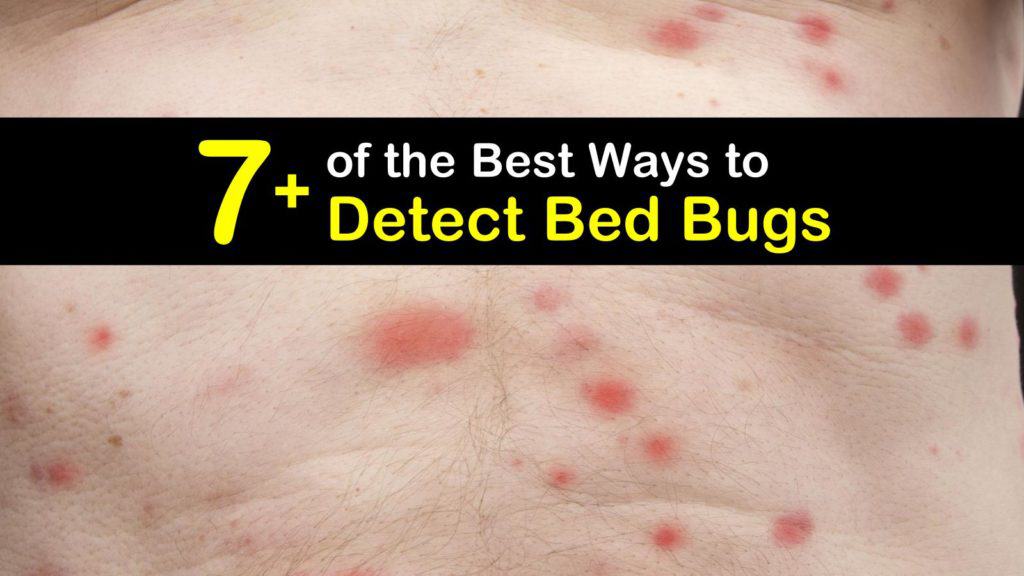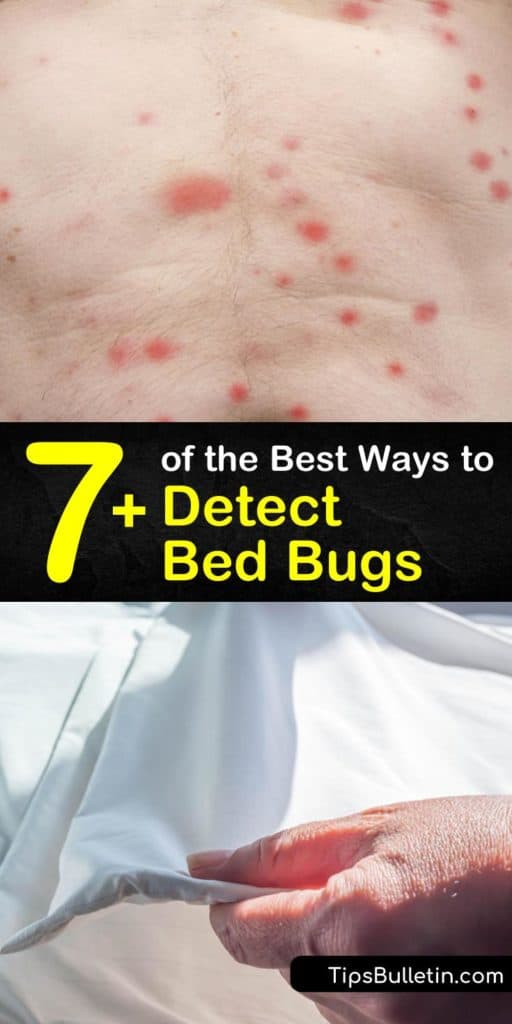how to find bed bugs
If you wake up with red insect bites on your skin, you might assume in a panic that you've got bed bugs. Before rushing to call an exterminator, it's a good idea to educate yourself about how to detect bed bugs and what these nasty bloodsuckers even look like.
Cimex lectularius, the common bed bug, has a flat, oval, brown body that turns reddish-brown after feeding. Young bed bugs, known as nymphs, are paler but also turn dark after a blood meal. The pests have six legs; short, thick antennae; and functionless wing pads.
If you're concerned that you might have a bed bug problem, you may be asking yourself, "How small are bed bugs?" Adult bed bugs are about the size of an apple seed, while nymphs are about the size of a poppy seed.
Unfortunately, female bed bugs lay at least 200 eggs throughout their lifetime. Before a nymph undergoes one of its five moltings or a female lays eggs, it must feast on blood.
Under certain circumstances, young bed bugs can survive for about three months without a blood meal, and adults over a year.

- How to Identify Bed Bugs
- How to Identify Bed Bugs Based on Their Bites
- Looking for Blood Stains
- How to Identify Bed Bugs using Fecal Spots
- How to Detect Bed Bugs Based on Physical Clues
- Using Your Nose to Identify Bed Bugs
- How Small are Bed Bugs? – And How to Find Them
- How to Detect Bed Bugs with Special Tools
- Calling a Professional to Confirm a Bed Bug Infestation
- How Do People Get Bed Bugs? How to Prevent Them
- What to Do if You Find Bed Bugs
How to Identify Bed Bugs
No bed bug identification method is completely reliable. However, if you're willing to do some inspecting and some research around questions like "How small are bed bugs?" you can likely piece together enough clues to determine whether you're facing an infestation.
Can bed bugs live without a host? Unfortunately, bed bugs can live up to a year without feeding.
How to Identify Bed Bugs Based on Their Bites
Bed bugs are attracted to the carbon dioxide that humans and pets exhale as we sleep. Their bite is painless since they inject an anesthetic. Your body may take up to 14 days to react to the puncture.
Some people don't react at all, while others react a little, and a few have a severe allergic reaction in the form of itching and red welts. The good news is that bed bugs are not known to spread diseases.
You may be wondering what bed bug bites look like. They're raised, round, and red. Unlike hives, they tend to have a consistent size and even edges.
Bedbug bites may form a straight line, zigzag, or cluster. They tend to be on exposed skin, such as along the edge of a sheet. Unlike flea bites, bed bug bites most often occur on the upper half of the body.
Looking for Blood Stains
It may not be very pleasant, but one sign that you may be infested with bed bugs is the presence of blood spots on bedding. These pests release an anticoagulant as they bite to make blood flow more freely, which can cause blood droplets to drip onto your bed sheets.
It's also possible that you unintentionally crushed a blood-stuffed bug. Of course, there could be another reason for the stains, so look for other clues.
How to Identify Bed Bugs using Fecal Spots
Besides red blood stains, you'll likely notice small dark spots from bed bug feces. The marks are usually black or brown but may also be rust-colored. The feces stains smell unpleasant and may smear upon contact.
To test whether stains come from bed bug droppings, wipe them with alcohol, glass cleaner, or baby wipes. If they dissolve into a reddish-brown color, they're probably the remains of bed bug excrement.
The dark spots most often appear around favorite bed bug hiding places, such as around mattress seams. They may, however, also show up on walls. On hard surfaces, the fecal stains look like small black spots.
How to Detect Bed Bugs Based on Physical Clues
Mysterious stains on sheets aren't the only thing that bed bugs leave behind. Since they shed skins as they pass through their different life stages, you might find tiny, pale-yellow exoskeletons in your bedding.
Bed bug eggs are white and tiny—about the size of a pinhead. They're almost impossible to see, especially since they tend to be hidden in cracks and crevices. However, white spots could be another indication of the presence of bed bugs, as could minuscule eggshells.
Although bed bugs don't build nests, they do tend to live in clusters. They start in human sleeping areas but may spread to surrounding areas if their population is large enough.
Using Your Nose to Identify Bed Bugs
If you're curious about how to detect bed bugs, you have more options than looking for the mess they leave behind and waiting for one to bite you. Besides their stinky droppings, the pests release pheromones through glands on the lower side of their body.
The smell is musty yet sweet—similar to the scent of a wet towel—and strongest if there's a heavy infestation. Otherwise, it may be necessary to rely on other signs of bed bugs.
How Small are Bed Bugs? – And How to Find Them
Spotting live bed bugs—or dead ones—is the only way to be certain of their presence. Bed bugs hide in spaces as narrow as a credit card. In fact, an old credit card cut in half to form a triangle is a useful tool for swiping in cracks.
A flashlight and magnifying glass are also helpful as you hunt for bed bugs. A nighttime search may be more successful since that's when the bugs are most active.
Start with beds, including creases and staples in mattresses and box springs. Remove linens and check them carefully. Lift mattresses up one corner at a time, and inspect bed frames and headboards.
Widen your search to surrounding areas, including cracks in baseboards and behind loose wallpaper. Next, focus on furniture, removing drawers and cushions, and checking all seams and gaps. Other possible bed bug hiding spots include clothing, curtains, and carpets.
How to Detect Bed Bugs with Special Tools
Home improvement stores sell devices that trap bed bugs. Although the interceptor cups don't kill the pests, they do confirm that you have a bed bug problem. Place the cups under bed legs.
The bugs climb the traps' exterior but slide down their slippery interior. For the cups to be effective, ensure that they're the only route to the human lying in the bed by pulling the bed away from the wall and preventing bedding from dangling.
Empty the cups regularly and possibly relubricate them. Another option is mattress encasements, which either prevent the pests from reaching your mattress or trap ones that are already there.
If you're looking to trap bed bugs with one of these cases, leave it in place for at least one year. Remember that the bugs can survive that long without feeding on blood.
Calling a Professional to Confirm a Bed Bug Infestation
Although dealing with pest control is not most people's cup of tea, they do have expertise about how to identify bed bugs, along with proven tools and techniques.
Wherever you are in the bed bug detection process, if it seems at all likely that there's an infestation, you'll probably be contacting pest control eventually anyway.
One strategy that the pros might employ is canine scent detection. Since dogs' sense of smell is so powerful, they're often effective at picking up bed bug stink. However, this method is not always accurate.
How Do People Get Bed Bugs? How to Prevent Them
People often unintentionally carry bed bugs into houses and apartments. Never pick up a mattress or couch from the curb, no matter how tempting it might look.
Given that the answer to "How small are bed bugs?" is "quite small," it's not surprising that the pests easily catch rides unnoticed.
tb1234
Where to Check for Bed Bugs
- Used furniture
- Used books
- Used clothing
- Luggage
tb1234
The presence or absence of bed bugs does not necessarily reflect a house's cleanliness level. However, eliminate possible hiding spaces by clearing away clutter.
Vacuum often, especially around beds. Repair peeling wallpaper, tighten loose outlet covers and seal all cracks in walls and furniture.
In multi-unit buildings, bed bugs often travel through holes in walls to other apartments or rooms. It's a good idea to do a quick inspection when you arrive in a hotel room.
What to Do if You Find Bed Bugs
If you're looking up how to identify bed bugs, it's quite possible you're facing an infestation. If so, strongly consider hiring a professional. You want to get bed bug control right.
One home treatment for bed bugs is to wash all clothing and bedding with hot water and the highest dryer setting. Run non-washable items through a high-heat dryer for at least 30 minutes.
Bed bug treatment involves a combination of washing, heating, steam cleaning, freezing, vacuuming, and pesticides. If there are items that you cannot wash, heat, or steam clean, throw them out.
Some people swear that using baking soda for bed bugs is an ideal solution but there's not a lot of evidence that shows this to be true.
Vacuum daily with a corded vacuum with a HEPA filter and a non-cloth bag and hose. Dispose of vacuum bags in sealed plastic bags, and wash attachments in hot water and detergent.
Follow pesticide instructions carefully. For example, only use the pesticide on a mattress if it specifically mentions use for mattresses. Apply pesticide several times since it doesn't kill eggs.
You now know the answer to questions like "How small are bed bugs?' and "How do you identify bed bugs?"
Besides actually spotting one of the pests or waking up to a row of red bites, you might find blood spots, fecal stains, or tiny skins, or white eggs. You may also come across a musty smell.
You've also learned about tools like bed bug interceptor cups. Now that you're armed with knowledge about how to detect bed bugs, we encourage you to go put it into practice. Good luck!

If you found these bed bug identification tricks helpful, please share these pest control tips with your friends on Facebook and Pinterest.
how to find bed bugs
Source: https://www.tipsbulletin.com/how-to-detect-bed-bugs/
Posted by: samonscancest.blogspot.com

0 Response to "how to find bed bugs"
Post a Comment